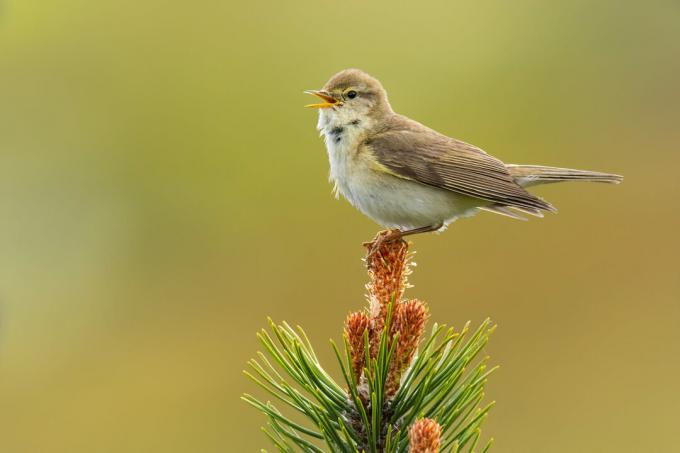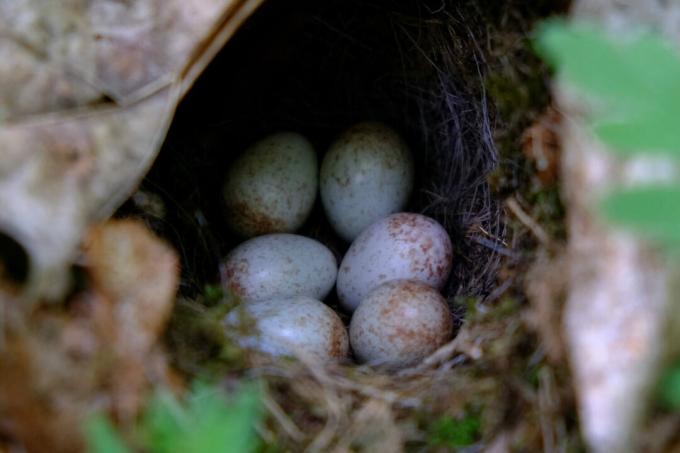The close relatives Fitis and Chiffchaff can easily be confused. We'll show you how the two birds differ, how you can recognize the fitis, and provide you with further information about the fitis warbler.

The Fitis (Phylloscopus trochilus) belongs to the genus of the warbler and is therefore also called the fiti warbler. It is a widespread songbird that is also native to German gardens. However, due to its simple appearance, the Fitis is easy to miss and even when it shows itself openly it often gets along with its far more common relative, the Chiffchaff, mistaken. So if you have the opportunity to watch a Fitis warbler in your own garden, you can count yourself lucky and will also be rewarded with an extremely lovely song. How to recognize the Fitis, differentiate it from the Chiffchaff and how to offer it an attractive home can be found here in our large profile - with pictures and other exciting ones Information.
contents
- Fitis: Wanted poster
-
This is how you recognize the Fitis
- How do you distinguish between Fitis and Chiffchaff?
- How does Fitis singing sound?
- How do you recognize a young Fitis bird?
- What do Fitis eggs look like?
- Which habitat does the Fitis prefer?
- Where does the Fitis build its nest?
- When is the fitis breeding season?
- Where does the Fitis spend the winter?
-
Support the Fitis in the garden: This is how it works
- What do Fiti warbler eat?
- Which nesting aids are suitable for the fitis?
- How can you additionally support the Fitis?
Fitis: Wanted poster
| size | Cira 11-13 cm |
| weight | About 10 g |
| Breeding season | May - July |
| lifespan | About 5 years |
| habitat | Light forests, parks and gardens |
| Feed preference | Insects and other small animals |
| Threats | Decline in food and living space |
This is how you recognize the Fitis
Green warblers are rather inconspicuous garden birds. The back, head and wing covers are of an olive green color and stand in slight contrast to the light, yellow-tinged underside. The only distinctive feature of the Fitis is a yellow over-eye stripe which, together with a yellowish cheek patch, frames a dark eye stripe. Unfortunately, male and female leaf warblers are visually indistinguishable.

How do you distinguish between Fitis and Chiffchaff?
The two bird species Fitis and Chiffchaff are visually very difficult to distinguish from one another. Typically, however, the warblers have light, orange legs, while those of the chiffchaff are dark. In addition, the Fitis has on average a longer and lighter over-eye stripe, which makes the entire facial markings appear more clearly than with the chiffchaff. However, these distinguishing features can vary widely and, depending on the lighting conditions, cannot always be clearly recognized. The best way to distinguish between Fitis and Chiffchaff is the singing: while Fitis has a melodic, has trilling singing, the chiffchaff sings its own name in a two-syllable, loud "Zilp-zalp-zilp-zalp".

How does Fitis singing sound?
Fiti foliage singers have a very lovely, clearly recognizable song. This consists of a short stanza of bright, clear whistling tones that starts quickly and then drops in pitch and ends in a few, more stretched notes. In addition to singing, the Fitis also has a reputation: "Hu-itt". However, this second bird call is less clear-cut and can easily be confused with other bird calls.
This is what Fitis chant sounds like:

How do you recognize a young Fitis bird?
Young Fitislaubsänger already look confusingly similar to their adult role models. On average, however, the young birds have a higher percentage of yellow feathers. While in the adult animals the breast is mainly colored yellow and the feathers on the belly turn into a dirty white, young birds are colored yellow on the entire underside.
What do Fitis eggs look like?
Fitis females lay between four and seven eggs. These are about 1.4 centimeters tall, with a whitish base color and covered with numerous light brown speckles. The eggs are embedded in a nest made of moss, grass, twigs and other parts of the plant, which is padded with fine feathers and hair.

Which habitat does the Fitis prefer?
Green warblers prefer semi-open habitats with areas of dense vegetation. They live in light deciduous and mixed forests, orchards, agricultural areas with hedge fringes or smaller groups of trees, large parks and wild, structured gardens.
Where does the Fitis build its nest?
The Fitis builds its nest in hedges, bushes and other low vegetation. The nest itself is usually covered and has a side entrance - similar to a small oven. It is erected very far down in the bushes, sometimes directly on the ground. Since it can be easy prey for cats and other nest predators, the nest is preferred to be hidden in very wild and dense vegetation.

When is the fitis breeding season?
The main breeding season of the Fitis lasts from May to July. During this time, most breeding pairs create one brood, and rarely a second brood. The eggs are incubated for 12 to 14 days after being laid. After the young birds have hatched, they are provided with food in the nest for a further 14 days as so-called "nestlings". Afterwards they undertake their first explorations in their surroundings and are supported as "branchlings" by their parents for a while in their search for food before they are left to fend for themselves.

Where does the Fitis spend the winter?
Since the warblers mainly feed on insects, they lack a basic food source here in winter. That is why the lively singers leave their breeding areas in the late year and head south. They travel long distances to meet their food needs and eventually winter in sub-Saharan Africa. In the spring they start their return journey and can be found back with us in May at the latest.
Support the Fitis in the garden: This is how it works
In our intensively used landscape, it is becoming increasingly difficult for the Fitis to find suitable habitats. That is why the songbirds move more often to habitats close to humans such as parks or gardens. Find out here how to make your own garden Fitis-friendly and provide a home for the splendid singers.
What do Fiti warbler eat?
Warbler feed mainly on insects, which they collect from leaves or twigs in their hopping flight. There are also other small animals such as spiders and molluscs on the menu, as well as berries and fruits. With birdseed in the form of grains or seeds, on the other hand, you cannot lure the small birds - especially since they leave us in the late year anyway and classic winter feeding has no effect would have.

But that does not mean that there is no other way to help the songbirds. With the design of a insect-friendly gardenyou can still ensure a plentiful supply of food. You can do this quickly and easily with ours, for example Plantura beneficial insect magnetwhich attracts a large number of small garden visitors and provides birds with a natural source of food.
Which nesting aids are suitable for the fitis?
As classic free brooders, leaf warblers prefer to build their nests themselves. A nest box does not help the little songbirds. These are more for half-cave and cave-brooders, such as Blue tits or Redstart, suitable. You can therefore better support the warbler by offering natural nesting places, for example shrubs or hedges deep into the ground. Also, be careful not to cut back too much, as the warblers need thick vegetation to protect their nests from intruders.

How can you additionally support the Fitis?
The intensive use of our landscape and the subsequent decline in food and habitat have made wild bird populations difficult for some years. If you want to counteract this development, you can advocate a sustainable and structurally rich design of our landscape. You can of course start in your own garden. For example, refrain from using chemical sprays, as these reduce the supply of insects and can even poison birds via the food chain.
Another insect eater that can only be found here in summer and that fills the air with its lovely song is that Blackcap. Get to know this garden bird better in our next species portrait.



